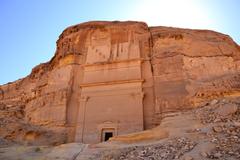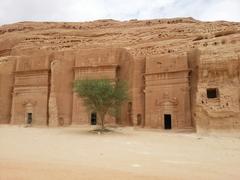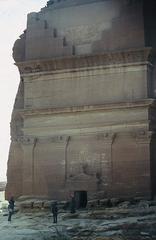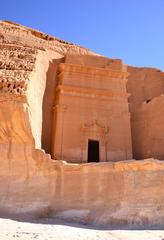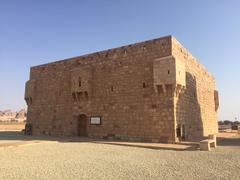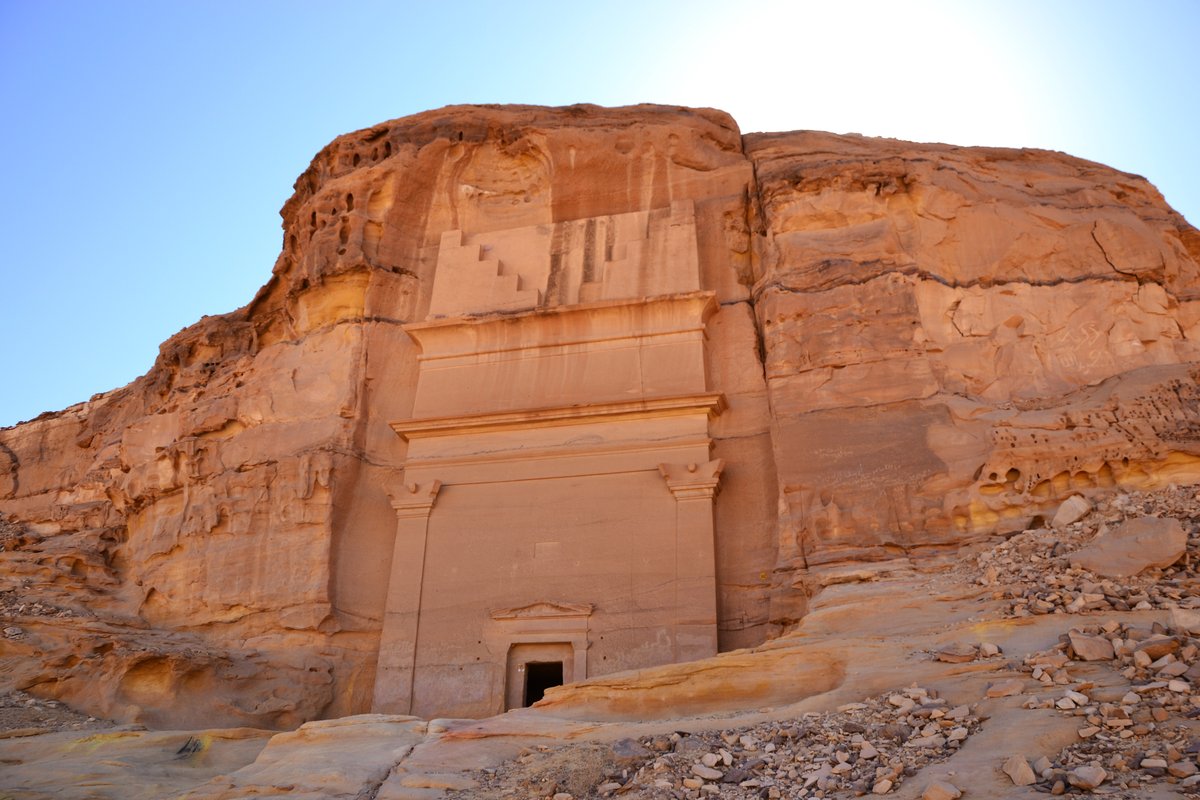
Qasr Al-Sanea Visiting Hours, Tickets, and Complete Guide to Medina Province’s Historical Sites
Date: 15/06/2025
Introduction
Qasr Al-Sanea (قصر الصانع), also known as Al Sanea Tomb, stands as one of the earliest and most architecturally significant Nabataean rock-cut tombs at the historic site of Madain Salih (Al-Hijr) in Medina Province, Saudi Arabia. Dating to approximately 50–100 CE, it is a remarkable representation of Nabataean funerary architecture, offering a window into the artistry, culture, and cosmopolitan influences that flourished along the ancient Incense Route. Its crow-step facade, Nabataean Aramaic inscriptions, and blend of Arabian, Hellenistic, and Roman motifs underscore its importance as both a cultural landmark and a testament to the social hierarchy and religious beliefs of its time (madainproject.com; saudipedia.com).
Designated as Saudi Arabia’s first UNESCO World Heritage Site in 2008, Madain Salih—encompassing Qasr Al-Sanea—bridges pre-Islamic traditions and Islamic narratives, including the story of Prophet Salih and the Thamud people. Whether you are a history enthusiast, cultural traveler, or scholar, this guide will equip you with all you need: visiting hours, ticketing, accessibility, travel tips, architectural highlights, and information on surrounding attractions (blog.wasalt.sa; en.ibnbattutatravel.com; The Traveler’s Buddy).
Table of Contents
- Historical Context of Qasr Al-Sanea
- Architectural Features and Artistic Elements
- Visitor Information: Hours, Tickets & Tips
- Cultural and Religious Significance
- Nearby Attractions and Experiences
- Frequently Asked Questions
- Summary Table: Key Facts
- Call to Action
- Sources
1. Historical Context of Qasr Al-Sanea
Nabataean Foundations and Al-Hijr’s Role
Qasr Al-Sanea is among the earliest monumental tombs at Madain Salih, the southernmost outpost of the Nabataean Kingdom, whose capital was Petra. From the 1st century BCE to the 1st century CE, Madain Salih thrived on the Incense Route, facilitating trade between southern Arabia and the Mediterranean. The Nabataeans were renowned for their rock-cut architecture and hydraulic engineering, with advanced water management systems supporting settlement in the arid desert (madainproject.com; mawdoo3.com).
Funerary Traditions and Regional Significance
Qasr Al-Sanea, dating to circa 50–100 CE, set the standard for over 100 subsequent tombs in Madain Salih. Its prominent location and elaborate design suggest it was commissioned by a high-status individual. The tomb’s blend of Arabian, Hellenistic, and Roman artistic influences reflects the cosmopolitan nature of Nabataean society (shrqyat.com).
After Roman annexation in 106 CE, Madain Salih retained its status as a regional center. Its connection to the Qur’anic narrative of Prophet Salih and the Thamud people adds a layer of religious significance (blog.wasalt.sa).
2. Architectural Features and Artistic Elements
Facade and Design
Qasr Al-Sanea’s facade, carved from reddish sandstone, features the early Nabataean “crow-step” motif crowning the entrance—thought to symbolize ascension. Above the entrance, inscriptions in Nabataean Aramaic detail the tomb’s dedication and provide insight into the social structure and language of the era (madainproject.com; en.ibnbattutatravel.com).
Interior and Construction
The tomb’s interior is a rectangular chamber with niches for family burials, contrasting the ornate public facade with a simple, functional space. The structure was carved top-down using iron tools, and the region’s dry climate has helped preserve both facade and inscriptions (mawdoo3.com).
Artistic and Cultural Influences
Qasr Al-Sanea incorporates stylistic elements from Arabian, Mesopotamian, Persian, Hellenistic, and Roman traditions. The inscriptions are of linguistic importance for Semitic studies and reflect the blending of cultures that defined the Nabataean elite (shrqyat.com).
3. Visitor Information: Hours, Tickets & Tips
Visiting Hours
- Standard Hours: 8:00 AM – 5:00 PM daily (subject to seasonal changes)
- Best Times: Early morning or late afternoon, especially October–April for cooler temperatures
Tickets
- Where to Buy: Online via official Saudi tourism websites or at the site entrance
- Pricing: Varies for residents, tourists, and children; guided tours may include entrance fees
- Advance Booking: Recommended during high season
Accessibility
- Pathways: Generally accessible, though some areas have uneven terrain
- Facilities: Basic amenities; bring water, sun protection, and comfortable footwear
Guided Tours
- Availability: Offered in Arabic and English; enhance understanding of the site’s context
- Booking: Through hotels, tourism offices, or official platforms (The Traveler’s Buddy)
Travel Tips
- Dress modestly in accordance with Saudi customs
- Respect prayer times and local etiquette
- Carry snacks and water, especially during hot months
4. Cultural and Religious Significance
Qasr Al-Sanea is closely associated with the Qur’anic account of Prophet Salih and the Thamud, enhancing its spiritual resonance. As a monument bridging pre-Islamic and Islamic traditions, it attracts historians, pilgrims, and cultural travelers alike. Its preservation as part of a UNESCO World Heritage Site underscores its global importance (blog.wasalt.sa; mallsruh.com).
5. Nearby Attractions and Experiences
- Other Tombs: Qasr Al-Farid and Khuraymat group
- AlUla Old Town: Traditional markets, local crafts, heritage events
- Natural Sites: Sandstone formations, date palm groves
- Cultural Events: Festivals and exhibitions at Madain Salih, especially during cooler months
For a richer experience, consider participating in guided tours, local workshops (e.g., pottery, calligraphy), and sampling Medina’s culinary offerings (Travellers Worldwide; Medina Hotels).
6. Frequently Asked Questions (FAQ)
Q: What are the visiting hours for Qasr Al-Sanea?
A: Typically 8:00 AM to 5:00 PM, but hours may vary by season.
Q: How can I buy tickets?
A: Online via official Saudi tourism websites or at the entrance.
Q: Is the site accessible to visitors with disabilities?
A: Pathways are generally accessible, but some uneven terrain exists. Contact the visitor center for assistance.
Q: Is photography allowed?
A: Yes, especially at sunrise and sunset; always respect restrictions and ask before photographing people.
Q: Are guided tours available?
A: Yes, in both Arabic and English. Advance booking is recommended.
Q: What should I wear?
A: Modest clothing; abaya for women is advisable, and men should wear long trousers and sleeves.
7. Summary Table: Key Facts
| Feature | Details |
|---|---|
| Date | ca. 50–100 CE |
| Culture | Nabataean |
| Location | Madain Salih (Al-Hijr), Medina Province, Saudi Arabia |
| Architectural Style | Early Nabataean rock-cut tomb, crow-step facade, rectangular chamber |
| Inscriptions | Nabataean Aramaic, above entrance |
| Function | Elite family tomb |
| UNESCO Status | Part of Madain Salih World Heritage Site (since 2008) |
| Visitor Access | Open year-round, 8:00 AM - 5:00 PM (en.ibnbattutatravel.com) |
8. Call to Action
Plan your journey to Qasr Al-Sanea and Madain Salih to explore the heart of ancient Arabia. Download the Audiala app for the latest guided tours, up-to-date visiting hours, and ticketing information. Follow us on social media for exclusive content and expert tips to enrich your experience. For further visitor resources, maps, and comprehensive guides, consult madainproject.com and mawdoo3.com.
9. Sources
- madainproject.com
- saudipedia.com
- blog.wasalt.sa
- en.ibnbattutatravel.com
- The Traveler’s Buddy
- Saudi Arabia Immigration
- Saudi Travel and Leisure
- Travellers Worldwide
- Medina Hotels
- mawdoo3.com
- shrqyat.com
- mallsruh.com
